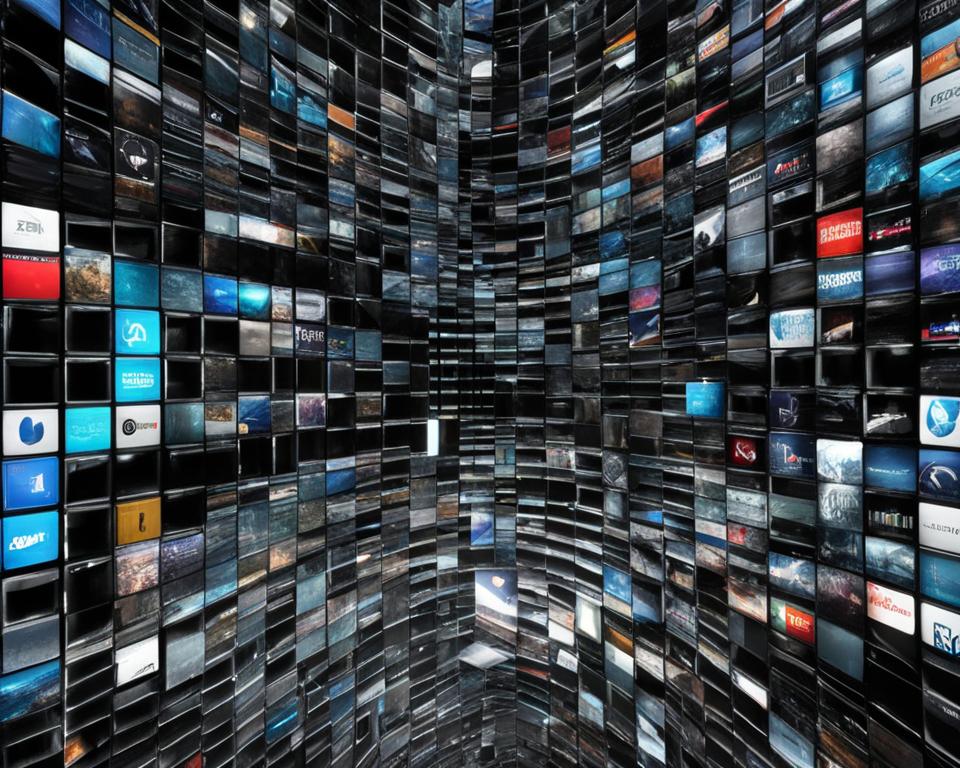Did you know that IPTV, or Internet Protocol Television, has revolutionized the way people consume TV content? This digital transformation has changed viewers from passive couch potatoes to engaged, active participants in their entertainment choices. Traditional linear TV is morphing and adapting to the digital age with the rise of streaming services and the Smart TV revolution.
Key Takeaways:
- IPTV has transformed television consumption by offering viewers more choices and convenience.
- Traditional linear TV is evolving to incorporate online streaming services.
- Viewers are becoming active participants in their entertainment choices.
- The digital transformation of TV has disrupted the broadcasting industry.
- IPTV has become increasingly popular among consumers, providing different access choices.
The Rise of Streaming Linear TV
Streaming linear TV has become the new norm in the world of online services. Platforms like Netflix now offer streaming linear TV services, similar to traditional broadcast channels. This format provides viewers with the convenience of accessing their favorite linear TV shows through online platforms. It utilizes the Electronic Program Guide (EPG), an interface familiar to viewers since 1981.
One prominent example of streaming linear TV is DAZN, often referred to as the “Netflix of sports.” DAZN has embraced the streaming linear TV model and has even started partnering with Pay-TV service providers to expand its reach. This collaboration signifies the growing significance of linear TV, even in the era of online streaming.
However, the COVID-19 pandemic has presented challenges for streaming services like DAZN. In response, these services have made strategic adjustments to their approach. They have begun focusing on collaborating with traditional TV providers to ensure a wider audience reach. This change reflects the evolving landscape of the TV industry, where linear TV remains an essential component despite the rise of streaming services.
In conclusion, streaming linear TV has revolutionized how viewers consume content. While online platforms offer a plethora of on-demand options, the availability of linear TV through streaming services demonstrates its enduring popularity. This adaptive approach ensures that linear TV continues to thrive, even in the ever-changing digital landscape.
The Evolution of Pay-TV & Aggregation of Streaming Services
Pay-TV, which includes traditional cable and satellite service bundles, is undergoing a transformation with the emergence of streaming services. While many may speculate that Pay-TV is dying, it is far from the truth. Instead, it is adapting to the changing landscape of television consumption.
One notable trend in Pay-TV is the aggregation of popular streaming services. Pay-TV providers are recognizing the demand for streaming content and are integrating these services as additional channels or Video On-Demand (VOD) stores. This convergence of broadcast TV and streaming services is blurring the boundaries between the two mediums, offering viewers a more diverse range of content.
An example of this convergence is the upcoming ATSC 3.0 NextgenTV in the USA. This technology will offer IP streaming over the air, combining the benefits of traditional broadcast TV with the convenience of streaming. Furthermore, the advent of 5G technology is expected to provide high-speed access to home TVs, enabling seamless streaming experiences.
While the integration of streaming services into Pay-TV brings more options for consumers, the business model of TV remains complex. Premium content still requires payment, either through subscriptions or advertising. As technology continues to evolve, the future of Pay-TV lies in finding a balance between traditional broadcast TV and the ever-expanding world of streaming services.
Benefits of Aggregation:
- Convenience: Viewers can access a wide range of content through a single platform or device.
- Choice: Aggregated streaming services provide diverse content options, catering to different viewers’ preferences.
- Seamless Experience: Integration of streaming services into Pay-TV eliminates the need for separate subscriptions or devices.
| Traditional Pay-TV | Aggregated Pay-TV + Streaming |
|---|---|
| Limited content options | Access to a broader range of content |
| Fixed schedule | Flexible viewing with on-demand content |
| Linear viewing experience | Personalized viewing based on preferences |
| Higher subscription costs | Choose only the streaming services you desire |

The evolution of Pay-TV and the aggregation of streaming services are reshaping the television industry. While the future may bring new challenges and complexities, the convergence of broadcast TV and streaming presents exciting opportunities for viewers to curate their own entertainment experiences.
Fragmentation of Content and Licensing Limitations
The transition from broadcast to online has led to the fragmentation of content, creating numerous apps and platforms that offer different selections. Instead of a central repository of content accessible to all viewers, the content landscape has become dispersed and fragmented.
This fragmentation poses challenges for viewers who now need to navigate multiple platforms to find the content they want. A viewer may have to switch between different apps or subscribe to various streaming services to access their favorite shows or movies. This fragmented content consumption experience can be frustrating and time-consuming.
Content licensing further complicates the situation. National and regional licensing restrictions limit the availability of certain content in specific locations. These limitations can restrict viewers’ access to popular shows or movies, making it difficult for them to enjoy the full range of content across different regions.
One area significantly impacted by licensing limitations is sports broadcasting. Broadcast deals often restrict the rights to show games on over-the-top (OTT) platforms. This means that even if a viewer has subscribed to an OTT service, they may not be able to watch a particular sporting event due to licensing restrictions.
The industry recognizes these challenges and continues to explore solutions to provide viewers with a seamless and comprehensive content experience. Efforts are being made to negotiate licensing agreements that allow for broader access and reduce regional limitations. The goal is to ensure that viewers can enjoy their favorite content regardless of their location or the platform they choose.
Image:

Prime Time Viewing and Changing Habits
Prime time viewing is a well-established phenomenon in the world of television. It refers to the period when the majority of viewers tune in to watch their favorite shows. Despite the changing landscape of TV, prime time viewing remains a consistent time slot that attracts a large audience.
Traditionally, prime time viewing occurred in the evening, typically after work and other obligations. It was a time when individuals could sit back, relax, and enjoy their favorite TV programs. Whether it was the latest episode of a popular sitcom or a thrilling drama series, viewers eagerly awaited their prime time content.
Today, prime time content is not limited to linear TV broadcasts. With the rise of digital platforms and streaming services, viewers now have more options than ever before. They can choose to watch their favorite shows on traditional linear TV channels or access a wide range of content on digital platforms.
The availability of more content and platforms, however, has presented a challenge for viewers. With a limited window of time to consume TV, selecting what to watch during prime time has become more difficult. The digitalization of TV has given viewers the freedom to change their viewing habits, but the overall viewing window has not significantly expanded.
Despite the abundance of content, prime time viewing remains popular during specific time slots. The demand for engaging and entertaining shows during these hours is evident, whether it’s the latest episode of a hit series or a live event. The digital age has enabled viewers to access prime time content through linear TV as well as digital platforms, providing them with more choices and convenience.
However, the challenge of choosing from a plethora of options still exists. Viewers must navigate through a variety of shows, genres, and platforms to find their preferred content during prime time. The digitalization of TV has both expanded and complicated the viewing landscape, requiring viewers to actively curate their own viewing experience.
As viewers continue to adapt their TV viewing habits to the digital age, the concept of prime time remains important. It signifies a dedicated window of time when viewers prioritize their TV consumption. Whether it’s linear TV or digital platforms, prime time viewing continues to captivate audiences and shape their TV viewing habits.
The Role of Users in Digital Television
The digitalization of television has brought about significant changes in the value chain of broadband services. Users now have the opportunity to play active roles as content distributors or producers, shaping the landscape of digital television. One of the key aspects of this transformation is the emergence of interactive television, which allows for greater viewer-programme interaction.
Interactive television enables users to engage with content in various ways, moving away from the traditional passive consumption model. This shift towards interactivity can be observed not only in digital television but also in other media entertainment domains such as music and news. With interactive TV applications, users can become participants in game shows or contribute to online discussions about TV programs, creating a more immersive and engaging viewing experience.
Through digital television, viewers have the opportunity to be more active and involved in their entertainment choices. They are no longer limited to being passive consumers but can actively shape their viewing experience through their interactions with the content. This level of user engagement has the potential to redefine the future of television viewing.
User Roles in Interactive TV Applications
| User Role | Description |
|---|---|
| Participant in Game Shows | Users can become contestants or participants in interactive game shows, where they actively compete and engage with the program. |
| Contributor to Online Discussions | Users can join online discussions about TV programs, sharing their opinions, insights, and reactions with other viewers. |
| Content Creator/Producer | Users have the opportunity to create and share their own content, contributing to the diversity and richness of digital television. |
| Content Curator | Users can curate personalized content playlists, selecting and arranging their favorite shows and channels for easy access. |

In the era of digital television, viewers are empowered to be active participants in their entertainment choices. Interactive television opens up new possibilities for user engagement and interaction, allowing viewers to go beyond being mere spectators. The future of television lies in the hands of the users, who can shape and co-create the content they consume.
Exploring Interactivity in Digital Television
Digital television has revolutionized the viewing experience by introducing interactivity. In the past, television was a one-way system with limited viewer-programme interaction. However, the expansion of digital channels has enabled more targeted content distribution, known as narrowcasting. This allows viewers to access content that is specifically tailored to their interests and preferences.
But interactivity goes beyond personalized content. Interactive functionality has been integrated into digital television to enhance user engagement. One example is the inclusion of interactive games related to live sports events. Viewers can actively participate and make predictions while watching their favorite teams compete.
Another approach is the cross-media approach, which combines different mediums to create a more immersive viewing experience. For instance, SMS voting or additional website information can be incorporated into TV programs, encouraging viewers to engage with the content in real-time.
| Interactive Features | Benefits |
|---|---|
| Interactive games | Enhanced user engagement and participation |
| Cross-media approach | Real-time interaction and access to additional information |
These interactive features increase user interactivity and add an extra dimension to the viewing experience. Viewers are no longer passive consumers; they can actively engage with the content they are watching.
Empowering Viewers through User Interactivity
User interactivity plays a key role in digital television, empowering viewers to take an active role in shaping their viewing experience. It enables them to make choices, express opinions, and engage with the content on a deeper level.
For example, viewers can participate in game shows by answering questions and competing against other contestants. This level of interactivity creates a sense of excitement and involvement, making the viewing experience more immersive.
Interactive television offers viewers the opportunity to not just watch, but also be part of the action.
In addition to gaming and participation in TV shows, user interactivity extends to online discussions about TV programs. Viewers can share their thoughts, opinions, and predictions with others, fostering a sense of community and enhancing the overall viewing experience.
- Engage in interactive games related to the content
- Participate in live TV shows and competitions
- Join online discussions about TV programs
The rise of user interactivity has transformed television from a passive medium into an interactive and engaging platform, enabling viewers to have a greater influence on the content they consume.
The Potential of Coviewing and Social TV
Coviewing and social TV are concepts that aim to make the viewing experience more interactive, personalized, and communal. Platforms like Twitch, Fortnite, and Netflix are examples of how coviewing can be achieved on a single screen.
Apps and platforms have been developed to overlay interactive functionality onto existing TV programming, allowing viewers to engage in real-time activities like betting, chatting, or playing games related to the content being watched. Coviewing creates a sense of community and allows for concurrent participation, eliminating the need for a second screen.
This shift towards social TV offers opportunities for personalized recommendations, targeted advertising, and more engaging brand experiences. It not only enhances the viewer’s experience but also provides valuable data for content creators and advertisers to better understand their audience.
With interactive TV and social platforms, viewers can actively participate in discussions, polls, or challenges related to the content they are watching. This level of engagement goes beyond traditional passive viewing and creates a more immersive and interactive experience.
“Interactive TV allows viewers to become active participants, transforming the way they interact with content and each other.”
Benefits of Coviewing and Social TV:
- Enhanced viewer engagement and interaction
- Creation of a sense of community and shared experience
- Opportunities for personalized recommendations and targeted advertising
- Real-time concurrent participation without the need for a second screen
- Access to additional content, games, or challenges related to the content being watched
By embracing coviewing and social TV, content providers and brands can tap into the power of interactive and communal viewing experiences. This can lead to increased viewer satisfaction, higher retention rates, and the development of stronger brand connections in the evolving landscape of digital television.
| Benefits of Coviewing and Social TV | Examples |
|---|---|
| Enhances viewer engagement and interaction | Platforms like Twitch and Netflix |
| Creates a sense of community and shared experience | Social media integrations in TV shows |
| Offers personalized recommendations and targeted advertising | Interactive TV platforms with user profiles |
| Allows for real-time concurrent participation without a second screen | Live chat features on streaming services |
| Access to additional content, games, or challenges related to the content being watched | Interactive quizzes during TV shows |
The Benefits of Interactive TV for Viewers and Brands
Interactive TV provides a range of advantages for both viewers and brands, transforming the way we engage with television content. By offering social engagement, personalized recommendations, relevant marketing, integrated campaigns, and new revenue streams, interactive TV revolutionizes the viewing experience.
One of the key benefits of interactive TV for viewers is the opportunity for social engagement. Viewers can actively participate in discussions, polls, and interactive games related to the content they are watching. This sense of community fosters a deeper connection with fellow viewers and creates a more immersive and enjoyable experience.
Additionally, interactive TV allows for personalized recommendations based on a viewer’s preferences and viewing history. Through advanced algorithms and data analysis, platforms can offer tailored content suggestions, ensuring that viewers discover new shows and movies that align with their interests. This personalized approach enhances the viewing experience and encourages viewers to explore a wider range of content.
Example:
“Interactive TV has transformed how I watch my favorite shows. The personalized recommendations have introduced me to new series that I otherwise would have missed. It’s like having a virtual TV guide that understands my taste in entertainment!”
– Emily, an avid interactive TV viewer
For brands, interactive TV provides innovative opportunities for relevant marketing. By leveraging user data and insights, brands can reach their target audiences with more tailored and less intrusive advertising. Customized ads seamlessly integrate with the content, enhancing the viewer experience and maximizing brand exposure.
Furthermore, integrated campaigns that combine traditional TV advertising with interactive elements allow brands to create a more engaging and memorable brand experience. These campaigns leverage the interactive nature of TV, encouraging real-time interactions and instant purchasing. Brands can offer access to exclusive merchandising, additional content, or special promotions, tapping into the growing market for virtual goods and in-game currencies.
Example:
“I love how interactive TV has made advertising more relevant and engaging. The customized ads are genuinely interesting, and I’ve discovered some fantastic products and services through them. The integrated campaigns provide a seamless brand experience, making me more likely to remember and engage with the advertised brands.”
– Mark, an interactive TV viewer and advertising enthusiast
In conclusion, interactive TV offers numerous benefits for both viewers and brands. It fosters social engagement, provides personalized recommendations, enables relevant marketing, facilitates integrated campaigns, and creates new revenue streams. The interactive nature of TV allows for real-time interactions and instant purchasing, making television a more interactive and personalized medium. As the popularity of interactive TV continues to grow, viewers and brands alike can look forward to a more immersive and engaging television experience.
| Benefits of Interactive TV | Viewer | Brand |
|---|---|---|
| Social engagement | Active participation in discussions, polls, and interactive games | Enhanced brand exposure and customer interaction |
| Personalized recommendations | Discover new content based on preferences and viewing history | Targeted advertising and tailored brand experiences |
| Relevant marketing | Less intrusive and more tailored ads | Maximized brand exposure and engagement |
| Integrated campaigns | Seamless brand experiences and instant purchasing | Increased brand loyalty and revenue potential |
| New revenue streams | Access to merchandising and additional content | Growing market for virtual goods and in-game currencies |
Overcoming Challenges and Embracing Change
The adoption of interactive TV faces challenges on both an institutional and cultural level. The legacy players in the TV industry must confront these challenges to ensure their relevance in an era of declining TV viewership and the rise of streaming platforms.
One of the main institutional challenges lies in the need for long-established TV habits and practices to evolve. The traditional model of passive TV consumption must make room for the interactive and social elements of viewing. Content providers and distributors need to be willing to open up their content for sharing and interacting, rather than locking it away. This shift in mindset is crucial to meet the changing expectations of viewers who now expect the same level of personalized and interactive experiences from television as they do from their digital devices.
On a cultural level, the industry must also grapple with declining TV viewership. As more viewers migrate to streaming platforms, broadcasters and content creators must find new ways to engage their audience and win back their attention. This requires a willingness to evolve and explore new formats, incorporating interactive elements that allow for viewer participation and engagement.
“Content providers and distributors need to be willing to open up their content for sharing and interacting, rather than locking it away.”
Legacy players in the TV industry should see this shift as an opportunity rather than a threat. By opening up their content, they can tap into the growing demand for interactive and personalized experiences, attracting viewers who are seeking more than just passive consumption. Embracing change also means embracing new distribution models and partnerships with streaming platforms, allowing for greater reach and exposure.
Furthermore, evolving with viewers means creating content that resonates with their changing preferences and habits. The younger generation, in particular, demands content that is interactive, personalized, and socially engaging. By understanding these preferences and adapting to them, legacy players can stay relevant and capture the attention of this important demographic.
The Benefits of Overcoming Challenges
Overcoming these challenges and embracing change offers many benefits for the TV industry. By opening up content and incorporating interactive elements, legacy players can attract a wider audience and increase viewer engagement. This can lead to higher viewer satisfaction, increased loyalty, and ultimately, improved viewership numbers.
Additionally, evolving with viewers allows for more relevant marketing and advertising strategies. By understanding viewers’ preferences and habits, brands can deliver targeted ads that resonate with their target audience. This leads to a more meaningful and impactful advertising experience for viewers, improving the overall viewing experience and strengthening the relationship between brands and consumers.
Opening up content and embracing change also opens up new revenue streams for the industry. Interactive TV allows for opportunities such as in-program purchasing, access to exclusive content, and partnerships with advertisers. These new revenue streams can help support the production of high-quality content and ensure the sustainability of the industry in the digital age.
Conclusion
The rise of IPTV and the popularity of streaming services have revolutionized the way viewers engage with TV content. Gone are the days of passive couch potatoes; today, viewers are active participants in their entertainment choices. While linear TV is not obsolete, it is certainly adapting and evolving to meet the demands of the digital age.
IPTV offers viewers a plethora of options, providing convenience and interactivity in their viewing habits. The emergence of online streaming services has drastically expanded the content landscape, allowing viewers to access a wide range of shows and movies on-demand. Additionally, IPTV enables viewers to enjoy their favorite content on various devices, including Smart TVs, giving them the freedom to watch anytime, anywhere.
However, the transition to IPTV comes with its fair share of challenges. Content fragmentation and licensing limitations present hurdles for viewers trying to find specific content across multiple platforms. The industry must address these obstacles and strive to create a seamless and user-friendly experience. Personalized and social viewing experiences are also becoming increasingly important for viewers, and content providers must cater to these needs to stay relevant in the evolving television landscape.
From couch potatoes to active viewers, the transformation brought about by IPTV is reshaping the future of television. As viewers’ expectations continue to evolve, content providers and distributors must embrace change and adapt to the digital era. By addressing the challenges and focusing on delivering quality content, IPTV has the potential to revolutionize the way we consume TV and provide a more engaging and immersive viewing experience for all.



